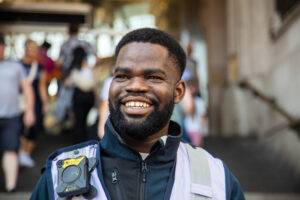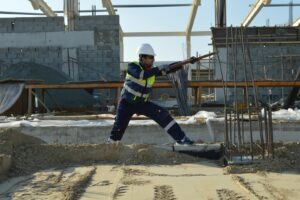
Syd Prior was the country’s oldest shop worker before he retired from his job at B&Q last month just short of his 97th birthday. He joined the DIY store 20 years ago, benefitting from the company’s policy of employing older workers.
In our latest article on the UK’s ageing population, Simon Hobbs and Alan Hatton-Yeo argue that if we are to harness the potential of older people we need to recognise individuality and encourage a voice and real influence
The big media story of the last few months has been the likelihood of a double dip recession and the European sovereign debt and banking crisis. This has led many to argue that the old paradigm of continuous economic growth is broken beyond repair.
Much has also been written about the need to rebalance the British economy, in other words how to move away from dependence on financial services and how to reduce the proportion of GDP spent on the public sector. Leaving aside the merits of these approaches, there are some other key ‘rebalancings’ which we feel need urgent attention. These are related to values and behaviours, as much as process.
Firstly, how do we promote a community-based approach to economic development which recognises and supports the resources and assets within the community?
Secondly, how do we encourage the development of the potential of individuals, and older people in particular?
Thirdly, how do we encourage connections between local people and decision makers so that they have real influence and good quality decisions and policy responses? And finally, how can we enable older people to use their skills to the best?
COMMUNITY-BASED APPROACHES
We have the opportunity to create a community-based approach to economic development and regeneration. In the past the emphasis has often been on bricks and mortar, growth in GDP and gross value added (the value of goods and services produced in a geographic area).
However, a paradigm based on economic growth and ‘competitiveness’ is incomplete. What has often been missing is the understanding that personal and local relationships are important to the local, real economy, as experienced day to day within communities.
The time is now right to rethink what we mean by ‘growth’ in the context of community-based solutions. How can we best work together to grow social capital within communities and support both the recognition of the assets people already possess and personal growth in confidence and skills needed to develop these further?
There is an increasing interest in the concepts of ‘place and community resilience’, that is, how communities deal with change and keep moving forward. The models put forward stress the interaction of the social, commercial and public economies and are concerned with community enterprise, social action, physical assets and financial resources.
These are valuable insights but we miss a trick if we don’t consider the individuals who make up the local community and its economy. The resilience of place is interwoven with the resilience of people.
Which factors support personal resilience and how do they relate to place? Personal resilience starts with having a roof over one’s head and is underpinned by a wide range of other factors including financial security, health and wellbeing and a sense of being valued as a family member and as someone who has a place within the community.
The strength of an individual’s social network is a crucial factor in personal resilience, as is the ability to actively contribute to the community. The personal relationships running through a community are also crucial. The resilience of individuals and the strength of social capital within a community are interdependent. Issues about one’s identity are central to the resilience of both older people and younger people in enabling them to deal successfully with the key transitions and changes they experience in their lives.
Of course older people are constantly and continuingly contributing to our communities and take an active role in a multitude of ways. But why does the discourse so often write them off? How can we challenge the stereotype of the older person as, at best, passive and at worst, a drain on resources?
We see this issue of individual identity as fundamental to building resilient communities. All of us as individuals have skills, experiences and aptitudes which help to define who we are. Age is only one dimension of this and we need to move the discourse around ageing away from the simplistic equation of length of life and deficit to a model that sees the individual for what they have to offer.
Perhaps much of what older people achieve is invisible to people who are not directly affected. On the other hand, patronising cultural stereotypes are a real barrier. One way of challenging them and linking people together is through intergenerational working.
Despite the pervasive stereotypes of older people many have always been highly active within their communities. Increasingly older people are becoming more visible as active role models in the world of work and in the media.
This lack of understanding of older people’s contribution has also manifested itself in the recent debates about older people stealing the inheritance of the future generations. The truth is very different as has been demonstrated by recent reports from the WRVS and Independent Age.
Older people, as grandparents, volunteers and supporters within their families, play an essential role in enabling young people to thrive and this is particularly important in the current economic circumstance.
As demographic change continues and as the pensionable age rises and incomes become tighter more people will want to work for as long as possible. Yet, according to the Office for National statistics (ONS) the over 50s have only a 10% chance of being re-employed if they lose their jobs. This is a major challenge but there are some causes for optimism.
Many employers, notably DIY chains and supermarkets, have been quick off the mark in recognising the skills and commitment that older people have. This makes sound economic sense for all concerned and challenges the stereotype of the ‘invisible’ older person. Another trend is in the growth in self-employment. Over 35% of the UK’s 3.5 million self-employed are over 50 years old. Many have become freelancers in their 50s and 60s by choice or by necessity following an enforced career change.
Other organisations such as the Princes Trust encourage mature workers to volunteer through its Young Enterprise programme to work with young people, helping them develop personal, teamwork and entrepreneurial skills.
How then can we support this process and promote the heterogeneity of older people’s skills and experience? How can we improve support for people wanting to set up community solutions such as local food enterprises, a credit union, community shops or local transport schemes? How might timebanking or local exchange trading schemes help?
Many local authorities have in the past given support, but as budgets come under increasing pressure increasingly support is being made available through national charities and organisations such as the Plunkett Foundation.
VOICE AND INFLUENCE
Third sector organisations, local authorities and the health community have a long history of engaging with older people as users of what traditionally has been thought of as ‘older people’s services’.
To be frank, the effectiveness of this has been mixed. Too often service users have been treated as passive recipients of services. Many organisations, partnerships and local authorities are now working around the Ageing Well agenda. This, together with the move towards commissioning interventions from a broader range of providers, brings more opportunities to rethink how best to do things.
Too often we have a deficit model of ageing, older people characterised as resource consumers who are dependent and need protecting. It is much rarer to find examples of engagement and dialogue about the positive contribution of older people. There is a golden opportunity to celebrate and promote the economic contribution of older people – now is the time for a more consistent engagement focused on how people can maintain their economic activity and refresh their skills in a commercial setting or by contributing to the local social economy.
The issues explored in this article beg a series of questions such as whether the business-led LEPs can make the intellectual jump necessary to enable the skills of the older generation to be unleashed. Can the government’s Work Programme contractors resist the temptation to go for the ‘low hanging fruit’ and tailor effective support to the individual’s needs as they age?
Can local authorities in their place shaping role find ways to engage older people in a more positive way? Can we move out of the older people’s services ghetto and engage with people to develop genuinely co-produced solutions? Can we move beyond thinking of residents being passive recipients of services and decisions – can we understand and mobilise the individual’s skills to help address local needs?
Can the commissioners of services really get under the skin to understand what individuals need and design services which are flexible enough to address the heterogeneity of people? Can they find ways to empower and support community-led initiatives? Can they understand the kind of support needed to promote social enterprise more effectively?
Can the commissioners establish a level playing field which encourages the sustainable growth of third sector providers? Can these providers access the investment capital and the skills needed to step up to the plate? Can they attract the volunteers necessary?
The answer to these questions, friends, is blowing in the wind… but if we fail to address these issues and don’t seize these opportunities to change our thinking everyone will be poorer for it.

Teenager Linda Williams with Rene Clayton, resident at Riverside House in Penkridge, South Staffordshire Housing Association’s supported living scheme.
Case study: Perceptions of Age, Penkridge, Staffordshire
The gap between young and older people is in danger of widening with both age groups experiencing negative stereotyping from the media and society. Perceptions of Age is part of the work of the Penkridge Neighbourhood Network Village Impact Partnership which promotes good neighbourliness, community cohesion and pro-social behaviour.
Three intergenerational workshops focused on what the two age groups have in common, what they can learn from each other and attitudes to discipline. Perceptions showed a marked difference in the opinions of those who took part.
April Lewis, intergenerational community development worker at the Centre for Intergenerational Practice which is hosted by the Beth Johnson Foundation notes that: ‘None of the young people now believed their earlier perceptions of older people; all of the young people felt that the older people are also misjudged and many feel that they have a lack of choice and don’t feel listened to.
‘Many of the young people discovered that the older people were more fun, energetic and interesting than they thought they were going to be. Some felt that the older people were good role models particularly in how they have managed the challenges in their lives such as conflict and hardship. The older people commented that the young people were friendlier, more patient and respectful than they expected them to be.
‘The conclusion that the young and older people came to from this project was that they were all the same just a different age.’


















Leave a Reply